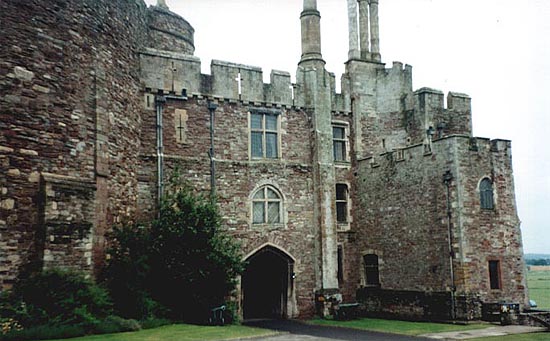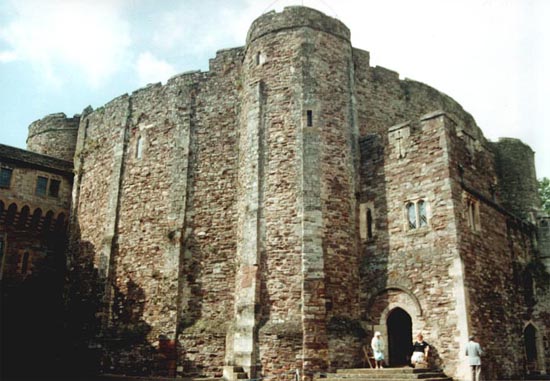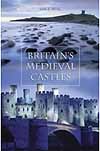Enigmatic Berkeley Castle
by Lise Hull
Berkeley Castle, in Gloucestershire, is something of an enigma. The castle's overall youthful appearance is largely the result of extensive re-building during the years from 1340-50, when Thomas, 3rd Lord Berkeley, pulled down much of the earlier castle. Even now, 650 years later, when standing before the battlements, it is easier to believe the work is an 18th or 19th century sham castle rather than what it truly is: an authentic ancient fortress that has been maintained in nearly perfect condition.

The site's history can be traced to the decades just prior to the Norman Conquest to the reign of Edward the Confessor, whose death precipitated the battle for England's throne. Apparently, Earl Godwin (father of the future King Harold II, who died at the Battle of Hastings) owned Berkeley Manor until 1066, but shortly after 1066, all of Godwin's estates were confiscated by the new king, William I, and redistributed to his loyal Norman supporters.
The Domesday Book, the medieval survey initiated by William the Conqueror to establish the exact extent of his new kingdom, recorded the introduction of the Berkeley family to these estates in 1086, when one of William FitzOsbern's tenants obtained the property and adopted Berkeley as his surname. The Norman king granted the estates at Berkeley to FitzOsbern, Earl of Hereford, as well as several others throughout the realm, including mighty Chepstow Castle, which is not too far across the border in Wales. More than likely, FitzOsbern built the first castle on the site, a typical motte and bailey structure of which little remains except for its original layout.
The first three Berkeleys were all named Roger, and it was during the third Roger's tenure that the family fell out of favor with the king, Henry II, due to their allegiance to his rival, the reigning monarch, Stephen. Consequently, Henry II granted Berkeley Castle to one of his own favorites, Robert FitzHarding, who became Lord Berkeley in 1153. Today's Berkeley family trace their ancestry to this man. However, their link actually goes back to the first Roger de Berkeley, for FitzHarding arranged the marriage of his son, Maurice, also known as "Make-peace", to one of Roger de Berkeley's daughters.
The first account of a stone structure at Berkeley dates to the 1150's, however, we can presume that some form of fortification was started shortly after the first Berkeley took control. The stronghold began as a typical motte castle, an earth and timber fortification, one of the hundreds thrown up in the decades immediately after the Conquest. As the hub of the Norman castle, the mound was initially crowned by a timber keep. By the mid-12th century, the keep had been replaced with a fine masonry shell keep. The oldest surviving structure at the castle, the sturdy keep rises some 60 feet tall.

The unusual stone keep still encompasses the base of the medieval motte, which is completely obscured beneath the masonry. Rather than adorning the summit as most shell keeps did during the Middle Ages, the rounded walling virtually engulfs the earthen mound. It remains a key part of the castle and has functioned as the focal point of activity during the centuries of its existence. Two of the keep's four original semi-round bastions have been transformed into small turrets and contain features of interest such as the well chamber, a small tower room with fine ebony furniture, Drake's Room, which holds some items that may have belonged to Sir Francis Drake, and the intriguing dungeon chamber, complete with pit prison, which played a crucial role in King Edward II's murder in 1327.
Shortly after his forced abdication, which was instigated by his wife, Queen Isabella (the so-called "she-wolf of France") and her treasonous paramour, Roger de Mortimer, the unpopular king was imprisoned inside the dungeon chamber in Berkeley Castle's great shell keep. The castle's prison consisted of a single room with a deep cesspit, or "oubliette", in one corner. Today, we are able to explore Edward's last home and can peer into the foreboding pit. The disturbingly real sight offers a vividly gloomy impression of his last, probably arduous, days on earth.
Due to his regal status, Edward was secluded in the sparsely furnished first floor chamber rather than being tossed into the pit to die. Nevertheless, his placement close to the pit served a grim purpose. Normally, prisoners were dropped down on top of the mass of flesh, but Edward was spared this fate. Instead, dead animal carcasses were tossed some 28 feet down into the dungeon, not just to create an unpleasant atmosphere for the prisoner but also because rotting bodies were known to emit toxic fumes, exposure to which the jailers believed would slowly poison and kill the king.
Ironically, Edward steadfastly managed to endure the torture, much to the chagrin of his wife and her lover, Mortimer. Angered by this twist of fate, the queen reputedly ordered her henchmen to slay her husband. The men chose a particularly gruesome way to emphasize the deed -- they skewered the king with a red hot poker.
Like many other Norman castles, Berkeley's keep was protected by two baileys. The modern appearance of these two wards is deceiving, and the casual observer would probably not recognize that the pretty courtyards are restyled baileys. But, in the 14th century restoration, Lord Berkeley lined the baileys with elaborate residential buildings, many of which are open to the public and showcase the splendor of the Middle Ages. Only the gatehouse has survived to mark the location of the outer bailey, but the inner ward has endured the debilitating effects of time with grace and fortitude, and an amazing display of carved woodworking. These structures give Berkeley Castle its distinctive character, which was partly defensive but fundamentally domestic.
The crowning glory is the Great Hall, which stretches some 62 feet long by 32 feet wide. Its ornate ceiling is adorned by exposed timber beams, which give the room its majestic presence. Fine tapestries, authentic furnishings and stained glass enhance the pleasing impression of medieval grandeur, which is complemented by the impressive kitchen and buttery, the formal dining room and the beer cellar, all of which are open to the public.
Even though the title of Earl of Berkeley no longer exists in British aristocracy, portions of the castle are still lived in by Berkeley descendants, making this the oldest castle in England consistently inhabited by a single family. They have lovingly cared for their inheritance and allow visitors to the castle and its marvelous gardens from Easter through the end of October. The property is an outstanding tribute to one of Britain's most enduring families.
More Historic Tidbits
For a brief time, Robert FitzHarding II, the first Robert FitzHarding's grandson, lost possession of the castle due to his opposition to King John, but Henry III gave the castle back to the Berkeleys in 1223, after he assumed the throne of England.
After the murder of Edward II and the remodeling program of the late 14th century, life continued uneventfully for the next 200 years, when the Berkeleys again lost possession. This time William, Lord Berkeley (also known as "Waste-all"), forfeited his rights to the estates, when he sold the castle to Henry VII in exchange for a marquisate and other titles. Berkeley remained a royal castle until the death of Edward VI in 1553, when the title and estates reverted to the Berkeleys for the final time.
The castle saw brief action during the English Civil War in the 1640's when it endured a three-day siege and capture by Parliamentary forces. Incredibly, Berkeley was one of England's few castles to withstand Cromwell's ruthless slighting campaign, which rendered them useless in further military action. At Berkeley Castle, the only damage of any significance is still visible: a 35 foot breach in the walling of the keep. In fact, even today, the Berkeleys are forbidden by law to repair the crack!
More Information:
We regret that we no longer have the resources to maintain up-to-date links and/or hours and pricing details for the various sites and attractions listed on this website. For more information about the location(s) listed above, please use your favorite search engine or visit Wikipedia.
 |
Lise Hull is a recognized authority on British castles and heritage, with a Master of Arts degree in Heritage Studies from the University of Wales, Aberystwyth, as well as a Master of Public Affairs degree, specializing in Historic Preservation, from Indiana University. She is the author of several of books on Britain, including Britain's Medieval Castles (Praeger: 2005), Great Castles of Britain and Ireland (New Holland: 2005) and Castles and Bishops' Palaces of Pembrokeshire (Logaston Press, 2005). Her work has appeared in numerous publications, including Military History Quarterly, Military History, Renaissance Magazine, Family Tree Magazine and Everton's Family History and Genealogical Helper magazines; she is also a regular contributor to Faerie Magazine. Visit her website at http://www.castles-of-britain.com. Hull also writes TimeTravel-Britain.com's Finding Your Roots column.
|
Article and photos © 2005 Lise Hull
|
